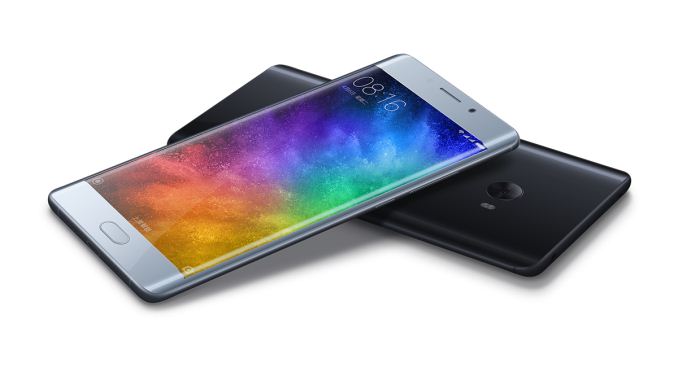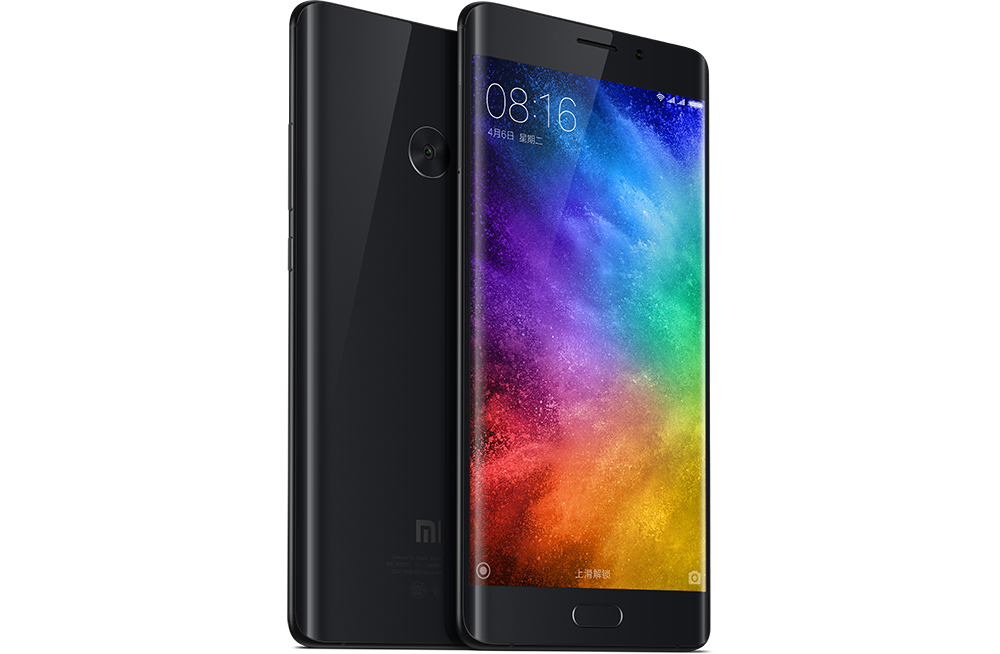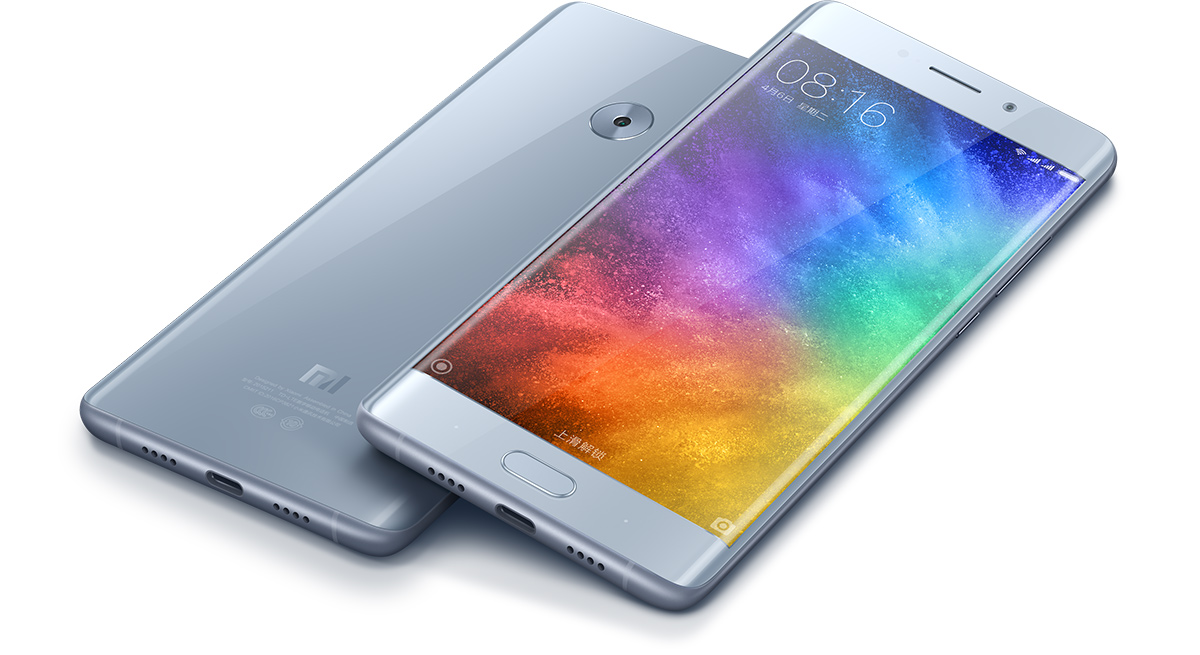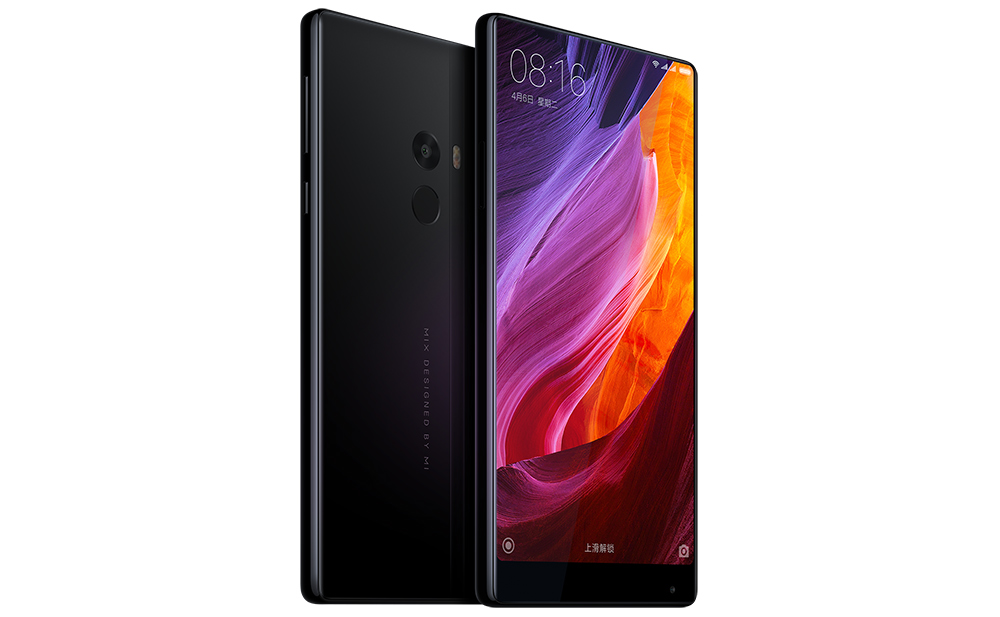Xiaomi Announces the Mi Note 2 (Snapdragon 821, 6GB RAM) and Mi MIX Concept Phones
by Matt Humrick on October 25, 2016 6:43 PM EST- Posted in
- Smartphones
- Mobile
- Xiaomi
- Mi
- Snapdragon 821

Xiaomi has added two new phones to its lineup: the Mi Note 2 and the Mi MIX. Both are flagship phones with large screens that emphasize performance and design; however, despite some overlap in criteria and internal hardware, these are two very distinct devices.
Like its predecessor, the Mi Note, the Mi Note 2 has an aluminum frame and a glass back with curved edges, but instead of the previous design’s flat front, the Mi Note 2 uses a flexible OLED display to allow curved edges to the front too, design features Samsung’s recent Galaxy phones also employ. Another obvious change from the previous model is the addition of a capacitive fingerprint sensor. The pill-shaped sensor, which sits below the screen and is flanked by capacitive navigation buttons, keeps the lower bezel relatively slim, giving the Mi Note 2 a screen-to-body ratio of 77.2%. The rear-facing camera sits flush with the shiny and smooth glass on the back and includes a slightly raised and polished ring to protect the lens.
The design is generally symmetric and balanced: The centered earpiece has the sensors and front-facing camera to either side, and the centered USB Type-C port on the bottom has matching arrays of holes for the downward-firing speaker and microphone. The offset 3.5mm headphone jack on the top edge and the dual-color LED flash on the back are the only features to break symmetry.
The Mi Note 2’s 5.7-inch OLED display delivers excellent black levels and covers 110% of the NTSC color gamut, according to Xiaomi, which basically means it should deliver highly saturated colors. For people who prefer more accurate colors, the phone provides an sRGB mode and a control for adjusting the display’s color temperature. Unfortunately, its 1920x1080 resolution is less than ideal for such a large display.
Inside the Mi Note 2 is Qualcomm’s latest Snapdragon 821 SoC, which includes four of its custom Kryo CPU cores and an Adreno 530 GPU, and a sufficiently large 4070mAh non-accessible battery that supports Qualcomm’s Quick Charge 3.0 fast charging technology. It also comes with either 4GB of RAM and 64GB of internal UFS 2.0 storage or 6GB of RAM and 128GB of storage, but there’s no support for microSD cards.
The 8MP front-facing camera includes autofocus and Xiaomi’s third-generation beauty mode processing. Around back is a 22.5MP Sony IMX318 Exmor RS sensor, which is among a new generation of sensors that use smaller 1.0µm pixels. Despite the reduction in full-well capacity, Sony claims its new sensor matches the image quality of its previous IMX230 Exmor RS sensor that uses larger 1.12µm pixels. Stacked above the sensor is a lens array with six elements and an f/2.0 aperture.
The Mi Note 2’s rear camera supports phase detect autofocus (PDAF) to improve focus speed. There’s no optical image stabilization (OIS), which could negatively impact low-light still image performance, but the camera does employ 3-axis electronic image stabilization (EIS) when shooting videos, even in 4K.
The Mi Note 2 comes in two different colors—Piano Black and Glacier Silver—and three different versions—two which will only be available in China and a global version that supports 6 modes and 37 frequency bands. The Mi Note 2 will be available in China starting November 1st for ¥2799 (4GB RAM / 64GB NAND) or ¥3299 (6GB RAM / 128GB NAND). The global version will cost ¥3499 (6GB RAM / 128GB NAND).
| Xiaomi Mi Note 2 | Xiaomi MIX | ||
| SoC | Qualcomm Snapdragon 821 (MSM8996 Pro) 2x Kryo @ 2.35GHz 2x Kryo @ 2.19GHz Adreno 530 @ 653MHz |
||
| Display | 5.7-inch 1920x1080 AMOLED | 6.4-inch 2040x1080 IPS LCD | |
| Dimensions | 156.2 x 77.3 x 7.6 mm 166 grams |
158.8 x 81.9 x 7.9 mm 209 grams |
|
| RAM | 4GB / 6GB LPDDR4 | ||
| NAND | 64GB / 128GB (UFS 2.0) |
128GB / 256GB (UFS 2.0) |
|
| Battery | 4070 mAh non-replaceable Qualcomm Quick Charge 3.0 |
4400 mAh non-replaceable Qualcomm Quick Charge 3.0 |
|
| Front Camera | 8MP, f/2.0, AF | 5MP | |
| Rear Camera | 22.5MP, 1/2.6" Sony IMX318 Exmor RS, 1.0µm pixels, f/2.0, PDAF, HDR, dual-tone LED flash | 16MP, f/2.0, PDAF, Auto HDR, dual-tone LED flash | |
| Modem | Qualcomm X12 LTE (Integrated) 2G / 3G / 4G LTE (Category 13/12) |
||
| SIM Size | 2x NanoSIM (dual standby) | ||
| Network | China | Global | China |
| FDD-LTE | B1 / B3 / B5 / B7 |
B1 / B2 / B3 / B4 / B5 / B7 / B8 / B12 / B13 / B17 / B18 / B19 / B20 / B25 / B26 / B28 / B29 / B30
|
B1 / B2 / B3 / B4 / B5 / B7 / B8 |
| TDD-LTE | B38 / B39 / B40 / B41 | B38 / B39 / B40 / B41 | |
| GSM | 850 / 900 / 1800 / 1900 | 850 / 900 / 1800 / 1900 | |
| WCDMA | B1 / B2 / B5 / B8 | B1 / B2 / B4 / B5 / B8 | B1 / B2 / B5 / B8 |
| CDMA | BC0 | BC0 / B1 / B10 / B15 | BC0 |
| TD-CDMA | B34 / B39 | B34 / B39 | |
| Wireless | 802.11a/b/g/n/ac, BT 4.2, NFC, IrLED, GPS/GNSS/Beidou | 802.11a/b/g/n/ac 2x2 MU-MIMO, BT 4.2, NFC, GPS/GNSS/Beidou | |
| Connectivity | USB Type-C, 3.5mm headset | ||
| Launch OS | Android 6.0 with MIUI 8 | ||
| Launch Price | 4GB/64GB: ¥2799 6GB/128GB: ¥3299 6GB/128GB (global): ¥3499 |
4GB/128GB: ¥3499 6GB/256GB: ¥3999 |
|
The larger Mi MIX was jointly developed with prolific designer Philippe Starck and features an all-ceramic body with ceramic buttons. The front is dominated by a 6.4-inch display with virtually no bezels along the top or sides, giving the phone a 91.3% screen-to-body ratio. The 5MP front-facing camera is located in the lower-right corner of the slim lower bezel, while the ultrasonic (instead of infrared) proximity sensor is located behind the screen. There are no physical or capacitive buttons in the lower bezel either, because it uses onscreen navigation controls.
Eliminating the upper bezel meant eliminating the traditional earpiece speaker too. In its place, the Mi MIX uses a piezoelectric-driven cantilevered beam that produces sound by vibrating the phone’s ceramic frame instead of a speaker driver. What’s not clear, though, is if people nearby will also be able to hear the conversation, or if the sound is directed only towards the user.
A circular camera sits flush with the ceramic back, stacked above a circular fingerprint sensor. A USB Type-C port sits centered on the bottom edge flanked by a symmetric array of small holes hiding a downward firing speaker and microphone. A 3.5mm headphone jack is on the top edge.
Its 6.4-inch IPS LCD display has an odd 17:9 aspect ratio that’s supposed to make room for the onscreen navigation controls while still providing a traditional 16:9 viewable area. Its 2040x1080 resolution seems low for such a large display, but it still provides a decent 362 PPI pixel density. Xiaomi claims a peak brightness of 500 nits and 94% coverage of the NTSC color gamut, making this a wide-gamut panel with more saturated colors. Like the Mi Note 2, the Mi MIX also provides a control for adjusting the display’s color temperature and a native sRGB mode.
Its internal hardware is also similar to the Mi Note 2’s, packing in an impressive list of hardware. The key differences are a larger 4400mAh battery and twice the internal UFS 2.0 NAND.
The Mi MIX will be available exclusively in China beginning November 4th and will come in two different versions. The standard version will cost ¥3499 with 4GB of RAM and 128GB of internal storage, while a special limited edition version, which comes with 6GB of RAM, 256GB of internal storage, and 18K gold-plated accents around the rear camera and fingerprint sensor will cost ¥3999.















53 Comments
View All Comments
amdwilliam1985 - Wednesday, October 26, 2016 - link
yeah, Mi Mix 6.4" is about the same size as iPhone 7 Plus, which is NOT one-hand-friendly. If we reduce Mi Mix to 5.5" or 6" then it will be one-hand-friendly.fred666 - Wednesday, October 26, 2016 - link
with no bezel this phone is not that much bigger than an iPhone Plus. Only a little wider and no taller.mat9v - Wednesday, October 26, 2016 - link
I don't get it frankly. Why can't I use both hands to operate the phone? Outside very strange emergency situations I should be able to use them. Playing with my phone while driving should not happen and outside of that.. no reason to use one hand. Beside that, big phone has many advantages over small one - easier to read, bigger battery, better multimedia experience, games anyone? Sure, your pockets may not like big phones and it's mostly a pain to sit down with such a phone in them but I would still choose big size :) And yeah, I use Xiaomi Mi Max and the battery lasts 3 days with 10 hours SOT or 7-10 hours of gaming :)fanofanand - Tuesday, November 1, 2016 - link
Try eating an ice cream cone while posting on Facebook. I believe that is the target market for most of these devices.hpglow - Thursday, October 27, 2016 - link
I would buy the mix right now to replace my note 4 if it were offered in north America.happymedium - Tuesday, October 25, 2016 - link
I vote we keep these sweat shop operators out of our markets.More jobs Americans will lose.
buy American!
amdwilliam1985 - Tuesday, October 25, 2016 - link
there are no smart phones made in America!Flunk - Wednesday, October 26, 2016 - link
Not since Motorolla gave up, no. There are no American smartphones.StevoLincolnite - Tuesday, October 25, 2016 - link
Rest of the world will keep buying more and more Chinese though and less American made stuff, the world market is larger than the US market.Your protectionist rhetoric won't turn the US economy around, it will just exclude you from participating in the worlds markets, it doesn't solve your issues and lack of competitiveness on the world stage.
Heck, I can't even remember the last time I bought an American-made product here, it used to be a common thing when I was younger.
If you Americans cannot compete on price, then you need to compete on Quality and Innovation and Service, loose that edge, and people will start to purchase Chinese stuff, why do you think Chinese phones are gaining traction? The Phone market has slowed and started to stagnate.
It's a hard pill to swallow if a Chinese Phone that is priced at $200 can do almost everything an American Phone that costs $1000 can do... And the American Phone doesn't get any support after a year on the market.
webdoctors - Tuesday, October 25, 2016 - link
I don't think its a fair comparison. What price is QCOM selling the 821 for in China? If the Taiwan and USA guys could get it at the same price, they'd sell their phones cheaper. The SoC is most of the phone and its all designed by QCOM in San Diego, so its hardly a "Chinese" phone technology wise, or as much as an Intel inside desktop by Lenovo...